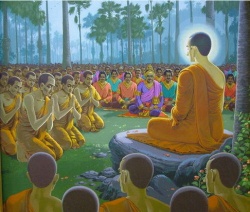Sutras
While Mahayana Buddhism reveres the Tripitaka as a holy text, they add to it a total of 2184 sacred writings. Most of these writings go under the name of Sutra. The Sutras were put into writing between the second century bce and the second century ce, during the time the split between Theravada and Mahayana developed. Since there are so many new works, different divisions of Mahayana develop in different directions depending on which Sutras they use and emphasize. Just a few, however, are key to much of Mahayana development and thought.
The most important Sutra is the Lotus Sutra. It depicts a sermon by the Buddha to the assembled Bodhisattvas, buddhas and other beings in which he teaches the basis of Mahayana Buddhism. He emphasizes the goal of becoming a Bodhisattva, the notion of realizing one's own buddha-nature, and so on. The Lotus Sutra is used extensively in many forms of Mahayana and Vajrayana Buddhism, and is even the primary text for one strand of Mahayana, Nicheren Buddhism. (You can dip into a chapter of the Lotus Sutra by going here. Or, you can visit a site dedicated to Nicheren here.)
The Heart Sutra also plays an important role in Buddhism. It is short, only a page or two long, but it sets out the character of nirvana, Emptiness, and Ultimate Reality as perceived within Mahayana. In it, the Bodhisattva Avalokiteshvara describes the nature of the five skandhas: body (=form), feelings, senses, tendencies, and consciousness. It is often chanted and discussed, especially in Vajrayana. To read the Heart Sutra, go here or here.
A Sutra called "Land of Bliss" describes the Pure Land of Amitabha Buddha. It relates the vow of the buddha that enabled him to create the Land, and discussed what people must do to enter the Pure Land.
The Sutras of the Perfection of Wisdom (Prajna-paramita) provides the basis for Mahayana's understanding of the key notion of "Emptiness." Nagarjuna used this text as a basis for his thought and writings. The Heart Sutra is part of this larger text.
